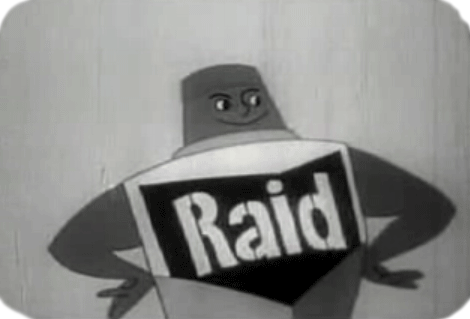For many of us, the ultimate solution for cockroaches and bed bugs and other household pests is the “bug bomb.” Remember the old Raid commercials, where bugs flee from Mr. Raid, only to be followed home by the ominous cloud of death? The implication is that the cloud from a bug bomb is like a heat seeking missile, able to follow pests into their deepest safe houses.
So how well do bug bombs really work? It turns out, not nearly as well as the animated ads suggest. Give a bed bug even a slip of cotton fabric to hide under, and even highly pesticide-susceptible bed bugs are unaffected by a total release fogger (bug bomb) blowing its top only a few feet away. This, according to a study conducted at Ohio State a few years ago.
Pest control professionals have long known that bug bombs in kitchens and other areas rarely eliminate cockroaches. Rather they seem to drive pests deeper into walls and utility areas. It turns out that aerosol insecticides do not penetrate cracks and crevices where pests spend most of their time.
Then there’s the growing concern about safety. A recent CDC report documented 3200 illnesses resulting from use of TRFs in just a few states between 2007 and 2015. Of these cases, 92% occurred in homes. Symptoms of exposure included cough, shortness of breath, chest irritation, vomiting, nausea, and cramping. 78% of cases were classified as low severity, and four out of the 3,222 cases were fatal. Some cases occurred when users did not vacate the treated areas while treating. Other times people entered too soon, or before the home was adequately aired. Moderate and severe illnesses occurred in men over 60, people with preexisting asthma, or who did not leave the treated area as instructed on the label.

Insects that escape into cracks and crevices are tougher than TV ads would have you believe. Insecticide fogs are not designed to penetrate under or inside furniture or walls.
This is no “smoking gun” report, implying that TRFs cannot be used safely indoors. Rather it seems to indicate that many people are not following fogger label directions, and thus reaping unhealthy consequences.
And then there are those folks who guess as to how many bug bombs they need, rather than following the label. It seems to be a universal human belief that when it comes to insecticides, “if a little is good, more will be better.” But besides increasing the risk of pesticide overexposure, using too many TRFs can lead to explosions, especially when aerosol particles build up around an open flame, like a stove or water heater pilot. This fact helped elevate bug bombs into the follies section of Snopes.com (a myth busters website dedicated to exposing urban legends). In this case, Snopes investigated the idea that bug bombs might cause explosions and found that indeed explosions can result from using too many bug bombs at a time. One recent explosion, not only destroyed an apartment, but killed the owner’s cat.
The lesson from all this is that foggers are not very effective for insects that spend most of the time hiding, such as immature fleas, cockroaches, bed bugs and ants. They can help rid a room (temporarily) of flying insects, or insects otherwise in the open; but these problems are much less common. There are many other, better, ways of managing cockroaches and bed bugs that you can read about in the Citybugs website.
Personally, I don’t often recommend total release foggers. But if you choose to use one, take the time to calculate the size of the room (length X width X height) before your purchase. Then read the product label in the store to calculate how many TRFs you need. Do not buy or use more than recommended. It is a waste of money and potentially dangerous to you and your pets.
